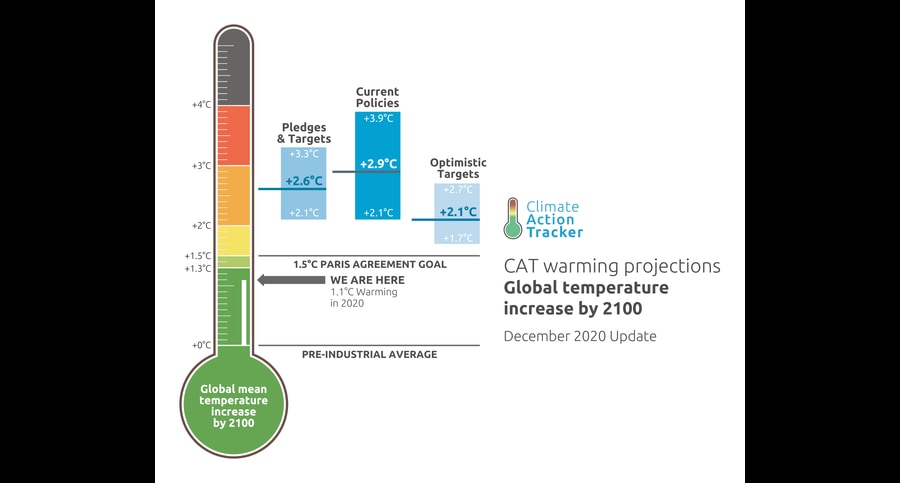A Modern Crisis
Over the last two centuries, we have made unprecedented advances in technology, science, economy, and quality of life. Alas! Industrialisation didn’t come without consequences.
With industrialisation came the modern world. With the modern world came modern problems. And with that, the urgent need to take climate change concerns seriously.
Since climate change became a world topic in the 1980s, we have made multiple efforts to curb the negative impact on the climate. The Rio Summit in 1992. The Kyoto Protocol in 1997. Millennium Development Goals (MDG) in 2000. The 2010 Cancun Agreements. In 2015, the 17 Sustainable Development Goals were adopted. Yearly we have the UN Climate Change conferences, and many more conferences, meetings and agreements.
The Paris Agreement of 2015 is the latest iteration of such efforts. But are those efforts working? Evidence suggests they are not. The data below shows a steady increase in global temperature despite our efforts.

Source: https://climate.nasa.gov/vital-signs/global-temperature/
The Rio Summit and Kyoto Protocol failed to deliver the promise they made, and the Paris Agreement of 2015 looks like it is heading in the same direction.
Is the Paris Agreement Doomed?
The USA, under Donald Trump, pulled out of the Paris Agreement. And the nations that have agreed to ratify it have made modest promises. According to the data below, global temperature could rise by almost 3° C if current policies continue. Even if the countries meet their pledges and targets, the temperature could still increase by 2.6° C. That’s well above the Paris Agreement’s goal. This data shows an urgent need for drastic action.

Progress has been slow. But positive signs are emerging. Participating countries have updated their pledge to meet the Paris Agreement goals. Let’s have a look at the data below.

According to the Climate Action Tracker, the EU has submitted an ambitious target to meet Paris Agreement’s requirements. China, Argentina and two more countries have proposed an improved pledge. This, while small, is a positive step.
What Biden’s Win Means
Then there’s the world’s second highest greenhouse gases emitter, the USA. Under Donald Trump, it pulled out of the Paris Agreement. And it has seen over 70 environmental regulations rolled back.
But if we are to believe incoming President Joe Biden’s announcements, then that is about to change. He has vowed to re-join the Paris Agreement. And has made plans to spend extensively for a greener future by spending two trillion dollars over 4 years. His climate change cabinet includes some strong players in the industry who have a proven record in incorporating climate policies.
In a December press release, Biden said he would hold a climate summit within 100 days after taking office. He also pledged to achieve net-zero carbon emission by 2035.
These are early promises, but if they hold true, then that’s a massive boost for the rest of the world to make the Paris Agreement work. And to become carbon-neutral. Plus, 2020 has shown us what a world free of air pollution could look like.
COVID-19: A Glimpse into the Future?
The COVID-19 crisis dominated 2020. Stay-at-home orders, lockdowns, travel bans. According to a Yahoo Finance video shown below, air quality in major cities improved significantly during lockdowns. Also, CO2 emissions dropped by 9%.
While this improvement is temporary, it gives us a glimpse of a carbon-neutral world that the Paris Agreement is working towards. COVID-19 was the bane of 2020, but in some ways, it showed us the future we may envision. But a sustainable future will not come without proper action.
Conclusion
Despite setbacks, the Paris Agreement is working… sort of… One reason for its success is its flexibility. Participating countries don’t need to meet mandatory targets. Instead, they can set their own targets. This flexibility allows countries to change their targets voluntarily as they see fit.
It is the latest step towards realising our hope of a cleaner future. And with incoming President Joe Biden promising to re-join the Paris Agreement, the world leaders can work together to build a carbon-neutral future.
The governments are doing their part. And now, we need to do our part. As individuals, we need to change our habits to support those who are working towards a sustainable future. We need to change our habits to abandon those who are not.
To know who’s working towards a sustainable future and who’s not, we can harness tools that measure the social and environmental impact of companies. THRIVE Project provides such a tool. At THRIVE, we do measure what matters most. And this is the first step you can take to contribute towards a better, more sustainable future.
References
Beckett, L., 2020. The Guardian. [Online]
Available at: https://www.theguardian.com/us-news/2020/dec/19/folks-crisis-joe-biden-environmental-advisers-haaland-kerry-granholm
Bourzac, K., 2020. C&EN. [Online]
Available at: https://cen.acs.org/environment/greenhouse-gases/COVID-19-pandemic-causes-6/98/i41?utm_source=YMAL&utm_medium=YMAL&utm_campaign=CEN&utm_content=pos1
Build Back Better, 2020. Build Back Better. [Online]
Available at: https://buildbackbetter.gov/press-releases/statement-by-president-elect-joe-biden-on-the-five-year-anniversary-of-the-paris-agreement/
Dennis, B., 2019. Washington Post. [Online]
Available at: https://www.washingtonpost.com/climate-environment/2019/11/04/trump-makes-it-official-us-will-withdraw-paris-climate-accord/
Environmental & Energy Law Program, 2020. Regulatory Rollback Tracker. [Online]
Available at: https://eelp.law.harvard.edu/regulatory-rollback-tracker/
[Accessed 2020].
Glueck, K. & Friedman, L., 2020. The New York Times. [Online]
Available at: https://www.nytimes.com/2020/07/14/us/politics/biden-climate-plan.html
[Accessed 2020].
USCUSA, 2020. USCUSA. [Online]
Available at: https://www.ucsusa.org/resources/each-countrys-share-co2-emissions























